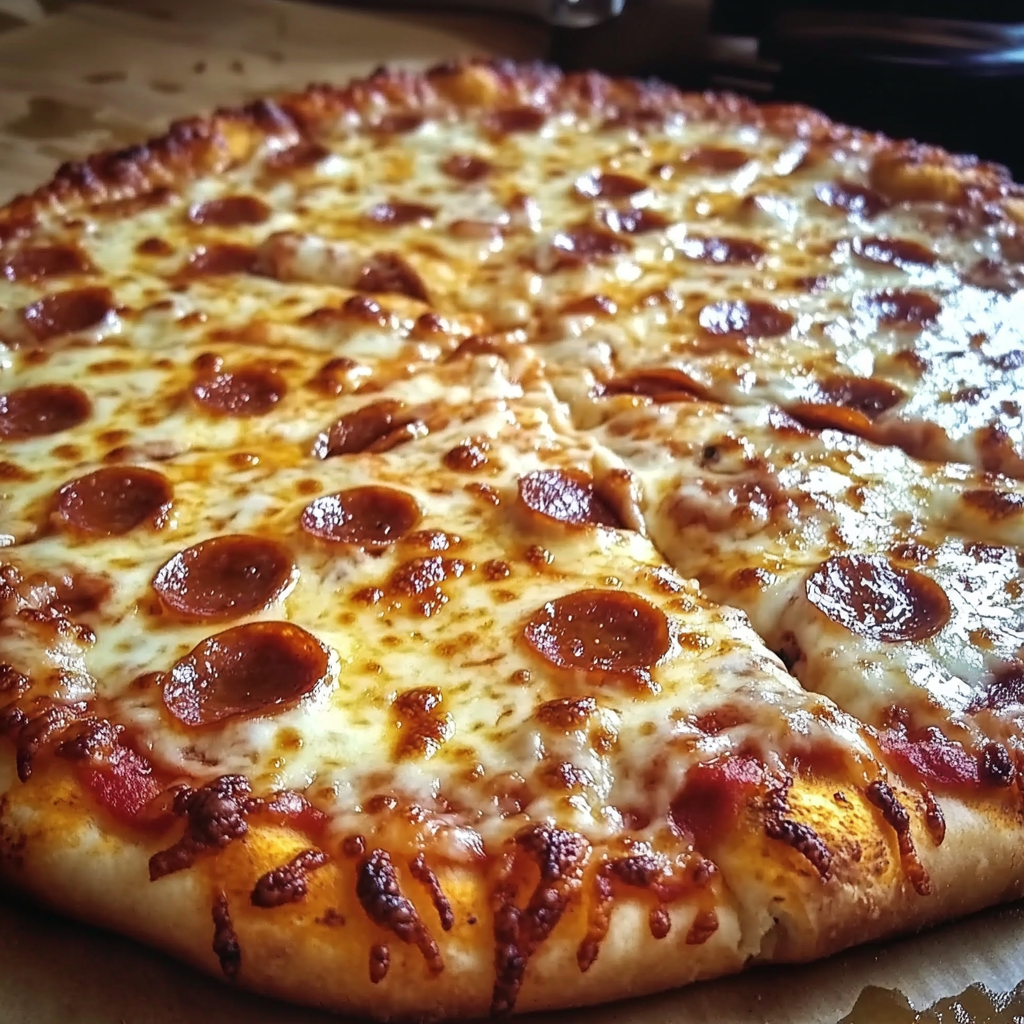Creating Pizza Hut-inspired dough at home is easier than you think. Known for its iconic fluffy texture and crispy edges, this crust is a favorite among pizza lovers worldwide. With just a few pantry staples and straightforward steps, you can replicate the magic in your kitchen.
This homemade dough recipe ensures that you achieve the perfect balance of flavor and texture. It’s not just about kneading the dough but understanding how each ingredient plays a role in bringing the crust to life. Whether you’re aiming for a pan pizza or adding creative toppings, this recipe is versatile and fun.
Mastering this homemade pizza dough will not only impress your family and friends but also save you the hassle of ordering out. With simple preparation and baking techniques, you can enjoy a slice of perfection right from your oven.
Understanding the Ingredients
The key to making a Pizza Hut-inspired dough lies in understanding the role of each ingredient. These six essential components work together to create the dough’s signature texture and flavor.
All-Purpose Flour
The backbone of any pizza dough, all-purpose flour provides the structure needed for elasticity. Its moderate protein content allows the dough to stretch without breaking, resulting in a perfect balance of chewiness and softness.
Dry Yeast
Yeast is the magic ingredient that makes the dough rise, creating its airy texture. By consuming the sugar in the mixture, yeast produces carbon dioxide, giving the crust its fluffy consistency. Make sure your yeast is fresh and properly activated for the best results. Learn more about yeast’s role in baking.
Sugar
A tablespoon of sugar isn’t just for sweetness. It acts as food for the yeast, encouraging it to ferment and rise effectively. This ingredient is crucial for achieving that subtle sweetness found in Pizza Hut’s crust.
Salt
Salt is a multitasker in this recipe. It enhances flavor, regulates yeast activity, and strengthens the dough’s structure. Without salt, your dough might taste flat and rise too quickly, compromising texture.
Warm Water
The temperature of your water is critical. At around 110°F (45°C), warm water activates the yeast without killing it. Too hot, and the yeast dies; too cold, and it won’t activate. Discover the science of water and dough.
Olive Oil
Olive oil contributes to the dough’s elasticity and prevents it from drying out during baking. It also adds a subtle richness that enhances the crust’s flavor profile. For authentic results, use extra virgin olive oil.
By understanding these ingredients, you’re one step closer to replicating the signature taste and texture of Pizza Hut’s dough.
Step-by-Step Dough Preparation
Making the perfect Pizza Hut-inspired dough requires precision and patience. Follow these steps to ensure a flawless outcome every time.
1. Mixing Dry Ingredients
Start by combining 2 cups of all-purpose flour, 1 teaspoon of salt, and 1 tablespoon of sugar in a large mixing bowl. This ensures that the salt and sugar are evenly distributed, which is crucial for flavor and proper dough formation.
2. Activating the Yeast
In a separate bowl, sprinkle 1 packet of dry yeast (approximately 2¼ teaspoons) over ¾ cup of warm water, heated to around 110°F (45°C). Allow it to sit for 5 minutes until frothy. This step ensures the yeast is alive and ready to help your dough rise. Not sure if your yeast is active? Learn how to test yeast before proceeding.
3. Combining Wet and Dry Mixtures
Slowly pour the yeast mixture into the dry ingredients. Add 2 tablespoons of olive oil and stir until the dough begins to form. If the dough feels too sticky, add small amounts of flour. For a softer crust, ensure the dough remains slightly tacky.
4. Kneading Techniques
Transfer the dough to a lightly floured surface. Knead it for 8-10 minutes until it becomes smooth and elastic. Proper kneading activates the gluten in the flour, which gives the dough its stretchy, chewy texture. Explore gluten’s role in baking.
5. First Rise
Place the kneaded dough in a greased bowl, cover it with a damp cloth, and let it rise in a warm spot for about 1 hour or until it doubles in size. This step is crucial for developing the dough’s airy structure.
6. Punching Down and Shaping
Once the dough has risen, punch it down to release trapped air bubbles. Roll it out to your desired thickness and shape it to fit your pizza pan or stone. This step sets the stage for your crust’s final texture.
By following these detailed steps, you’re well on your way to crafting a homemade pizza dough that rivals your favorite takeout. Check out visual dough preparation guides for extra inspiration.
Baking the Dough to Perfection
The final step to achieving the perfect Pizza Hut-inspired dough lies in the baking process. Every detail, from preheating the oven to choosing the right bakeware, plays a role in determining the crust’s flavor and texture.
1. Preheating the Oven
Set your oven to 425°F (220°C) and let it fully preheat. A hot oven ensures even cooking and helps the dough rise quickly, creating a fluffy yet crisp crust. Consider using a pizza stone to replicate the heat distribution of a commercial pizza oven. Learn more about pizza stones and their benefits.
2. Choosing the Right Bakeware
For a classic pan pizza, use a round, greased pizza pan. If you prefer a thinner crust, a pizza stone or perforated pan is ideal, as they allow better airflow. Make sure the pan is evenly coated with olive oil to create the iconic crispy edges.
3. Adding Toppings
Before baking, layer your dough with sauce, cheese, and your favorite toppings. Be mindful of the order—spread the sauce first, then add cheese, followed by toppings. Overloading the pizza can result in a soggy crust, so balance is key.
4. Baking the Pizza
Place the prepared pizza in the center of the oven for even heat distribution. Bake for 15-20 minutes or until the crust turns golden brown and the cheese is bubbly and slightly caramelized. Keep an eye on it during the last few minutes to prevent over-baking.
5. Cooling and Serving
Once baked, allow the pizza to cool for 2-3 minutes before slicing. This step helps the crust set and prevents the toppings from sliding off. For a professional touch, garnish with fresh herbs like basil or parsley before serving.
Perfecting the baking process ensures that your pizza crust achieves the ideal combination of crispy and fluffy. Explore creative pizza topping ideas to make your homemade pizza even more exciting.

Tips for Achieving Authentic Pizza Hut Flavor and Texture
Achieving the signature Pizza Hut crust at home requires a mix of technique and attention to detail. These tips will help you replicate the restaurant-quality flavor and texture that pizza lovers adore.
1. Use Olive Oil Generously
Before baking, brush the edges of your dough with olive oil. This step not only enhances the crust’s flavor but also creates the golden, crispy texture reminiscent of Pizza Hut’s pan pizza. Learn about the benefits of olive oil in baking.
2. Dough Thickness Matters
Roll your dough to the desired thickness depending on the type of pizza you want. For a pan pizza, aim for a thickness of about ½ inch, ensuring the dough evenly fills the pan. This creates the fluffy, airy texture that sets this crust apart.
3. Optimize Rising Time
Allow the dough to rise in a warm, draft-free environment. For an authentic flavor, consider letting the dough rise slowly in the refrigerator for 8-12 hours. This process enhances the dough’s flavor complexity, similar to what you’d find in a professional pizzeria.
4. Experiment with Cheese Blends
Use a mix of mozzarella, cheddar, and Parmesan to achieve a rich, gooey topping that complements the crust. The cheese blend is crucial for balancing the flavors of your homemade pizza dough.
5. Don’t Skip the Pan Grease
For an authentic Pizza Hut texture, grease your pan generously with olive oil or butter before placing the dough. This step ensures the bottom of the crust becomes crisp and flavorful during baking.
6. Use a Pizza Stone for Thin Crusts
If you prefer a thinner, crunchier crust, bake your pizza on a preheated pizza stone. It replicates the heat distribution of commercial ovens, producing the perfect crunch. Explore pizza stone benefits.
These tips will elevate your pizza-making game, ensuring your crust is as close to Pizza Hut perfection as possible.
5. Variations on the Classic Dough Recipe
One of the best aspects of making your own Pizza Hut-inspired dough is its versatility. Whether you’re catering to dietary preferences or experimenting with flavors, this dough can be adapted in countless ways.
1. Stuffed Crust Pizza
Transform your crust into a cheesy delight by making it stuffed. To do this:
- Roll the dough slightly larger than your pan.
- Place string cheese or shredded mozzarella around the edges, then fold and seal the dough over the cheese.
- Brush with olive oil or garlic butter before baking. This simple addition creates a cheesy crust that rivals the original. Explore stuffed crust techniques.
2. Thin Crust Adaptation
If you prefer a crispier crust, adjust the recipe slightly:
- Use less dough for the base and roll it out thinner than usual.
- Increase the oven temperature to 450°F (232°C) for faster, crispier baking.
- Bake directly on a pizza stone or perforated pan to enhance the texture.
3. Gluten-Free Pizza Dough
For those with dietary restrictions, substitute the all-purpose flour with a gluten-free blend. Add a teaspoon of xanthan gum to replicate the elasticity of gluten. Let the dough rest longer to ensure it hydrates properly before shaping. Discover tips for gluten-free pizza dough.
4. Herb-Infused Dough
Elevate your dough’s flavor by incorporating dried herbs like oregano, basil, or garlic powder into the flour mixture. This simple tweak creates an aromatic base that complements any toppings.
5. Whole Wheat Option
For a healthier twist, replace half of the all-purpose flour with whole wheat flour. This variation adds a nutty flavor and boosts the crust’s nutritional value without sacrificing texture.
By exploring these variations, you can tailor your pizza to suit any occasion or preference. Check out more pizza ideas for inspiration.
Common Mistakes to Avoid
Even with the best recipe, small mistakes can affect the quality of your Pizza Hut-inspired dough. Avoid these common pitfalls to ensure success every time.
1. Over-Kneading the Dough
While kneading activates gluten and gives the dough its elasticity, overdoing it can make the crust tough and chewy. Knead only until the dough is smooth and elastic, usually around 8-10 minutes.
2. Using the Wrong Water Temperature
Water that’s too hot will kill the yeast, while water that’s too cold won’t activate it. The ideal temperature is between 105°F and 110°F (40°C to 45°C). Use a kitchen thermometer for accuracy. Learn more about yeast activation.
3. Insufficient Rising Time
Allowing the dough to rise properly is essential for developing flavor and texture. Rushing this step results in a dense crust. For the best results, let the dough double in size in a warm place. If time permits, refrigerate the dough overnight for a richer flavor.
4. Overloading with Toppings
Piling on too many toppings can weigh down the dough, making it soggy in the center. Stick to a balanced amount, especially with wet ingredients like vegetables and sauces.
5. Forgetting to Grease the Pan
Skipping this step can cause the dough to stick, ruining its texture and making cleanup difficult. Generously grease the pan with olive oil or butter to prevent sticking and to create a crispy, golden crust. Explore more baking tips.
6. Ignoring Oven Preheating
Placing the pizza in an underheated oven can lead to uneven cooking. Always preheat the oven to the specified temperature for optimal results.
By avoiding these common mistakes, you’ll ensure that your homemade pizza dough is consistently delicious and perfectly textured

Frequently Asked Questions (FAQs)
Here are answers to some of the most common questions about making Pizza Hut-inspired dough. These tips will help troubleshoot and perfect your pizza-making process.
1. Can I Freeze the Dough for Later Use?
Yes! After the first rise, divide the dough into portions and wrap them tightly in plastic wrap or place them in airtight containers. Dough can be frozen for up to 3 months. To use, thaw it in the refrigerator overnight and let it come to room temperature before shaping.
2. What If I Don’t Have Olive Oil?
You can substitute olive oil with other neutral oils like canola or vegetable oil. However, olive oil adds a distinct flavor and helps achieve the signature texture. For an authentic taste, consider using extra virgin olive oil. Learn about olive oil’s role in baking.
3. How Can I Tell If My Yeast Is Still Active?
If your yeast doesn’t become frothy after 5-10 minutes in warm water with sugar, it may be inactive. Always check the expiration date on the packet and store yeast in a cool, dry place. Explore tips for working with yeast.
4. Is It Necessary to Use a Pizza Stone?
No, but using a pizza stone can enhance the crust’s texture by distributing heat evenly, especially for thin crusts. If you don’t have one, a regular baking sheet or pizza pan will work just fine. Learn more about pizza stones.
5. How Do I Achieve a Crispier Crust?
For a crispier base, pre-bake the crust for 5 minutes before adding toppings. Baking at a higher temperature (450°F or 232°C) can also help achieve the desired crunch. Using a perforated pan or pizza stone can further enhance the crispiness.
6. Can I Make the Dough Gluten-Free?
Absolutely! Replace all-purpose flour with a gluten-free blend and add a teaspoon of xanthan gum for elasticity. Be sure to let the dough rest longer for proper hydration. Check out gluten-free pizza tips.
These FAQs cover the most pressing concerns, ensuring your homemade pizza dough turns out perfect every time.
PrintPIZZA HUT-INSPIRED HOMEMADE DOUGH
This article is a comprehensive guide to creating a Pizza Hut-inspired homemade dough. It delves into the essential ingredients, step-by-step preparation, and baking techniques to help readers replicate the iconic texture and flavor of Pizza Hut’s crust. The guide also includes tips for achieving professional-quality results, variations to suit different dietary needs, common mistakes to avoid, and answers to frequently asked questions. With integrated external and internal links for further learning, it provides a complete resource for pizza enthusiasts.
- Author: Clara
Ingredients
- 2 cups all-purpose flour
- 1 packet dry yeast (about 2¼ teaspoons)
- 1 tablespoon sugar
- 1 teaspoon salt
- 3/4 cup warm water (110°F or 45°C)
- 2 tablespoons olive oil
Instructions
In a large mixing bowl, combine the flour, salt, and sugar.
Sprinkle the yeast over the warm water and let it sit for about 5 minutes, or until it becomes frothy.
Add the yeast mixture and olive oil to the dry ingredients.
Knead the dough on a lightly floured surface until it becomes smooth and elastic, about 10 minutes.
Place the dough in a greased bowl, cover it, and let it rise in a warm place until doubled in size, about 1 hour.
Punch down the dough, then roll it out to fit your pizza pan or stone.
Add your favorite toppings and bake in a preheated oven at 425°F (220°C) for 15-20 minutes, or until the crust is golden brown and toppings are cooked.
Notes
- Flour Selection:
- Use all-purpose flour for the best balance of chewiness and softness.
- For a healthier option, substitute half with whole wheat flour.
- Yeast Activation:
- Ensure the water temperature is between 105°F and 110°F (40°C to 45°C) to activate the yeast without killing it.
- If the yeast doesn’t foam after 5-10 minutes, it may be inactive, and fresh yeast should be used.
- Kneading Tips:
- Knead until the dough is smooth and elastic, about 8-10 minutes.
- Avoid over-kneading to prevent a tough crust.
- Rising Environment:
- Allow the dough to rise in a warm, draft-free space. An oven with the light on works well.
- For deeper flavor, refrigerate the dough overnight after the first rise.
- Greasing the Pan:
- Coat the pizza pan generously with olive oil or butter to achieve a crispy base and prevent sticking.
- Rolling and Shaping:
- Roll the dough evenly to avoid thin spots that may burn.
- For stuffed crust, seal cheese sticks or shredded cheese around the edges.
- Baking Tips:
- Preheat the oven to 425°F (220°C) for even cooking.
- If using a pizza stone, preheat it for 30 minutes before placing the dough on top.
- For a crispier crust, pre-bake the dough for 5 minutes before adding toppings.
- Customizing the Flavor:
- Add dried herbs (oregano, garlic powder) or grated Parmesan to the dough for added flavor.
- Experiment with your favorite toppings but avoid overloading the pizza to prevent a soggy crust.
- Storing Leftovers:
- Wrap leftover dough in plastic wrap or store in an airtight container in the refrigerator for up to 3 days.
- Freeze extra dough for up to 3 months and thaw overnight in the refrigerator before using.
- Serving Suggestions:
- Pair the pizza with fresh salads, garlic bread, or dipping sauces for a complete meal.
- Garnish with fresh basil or parsley for a professional touch.





